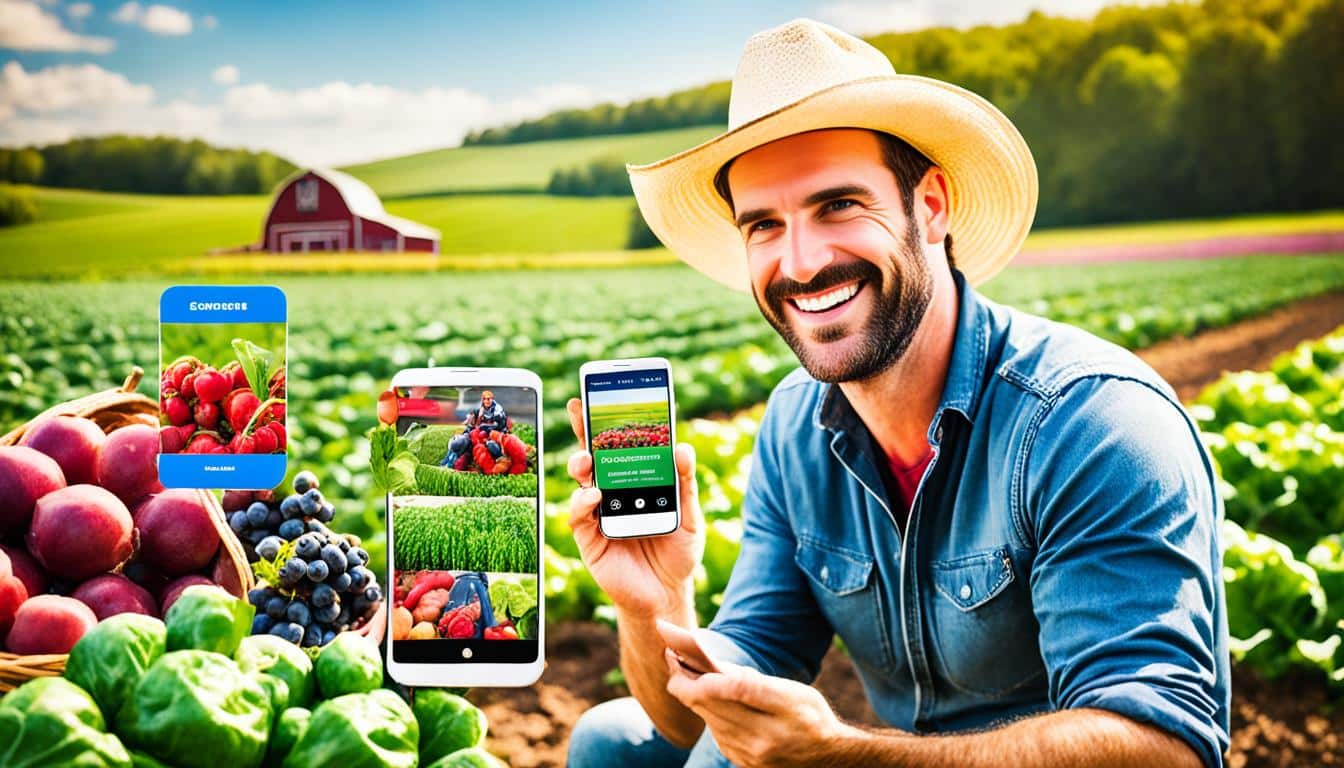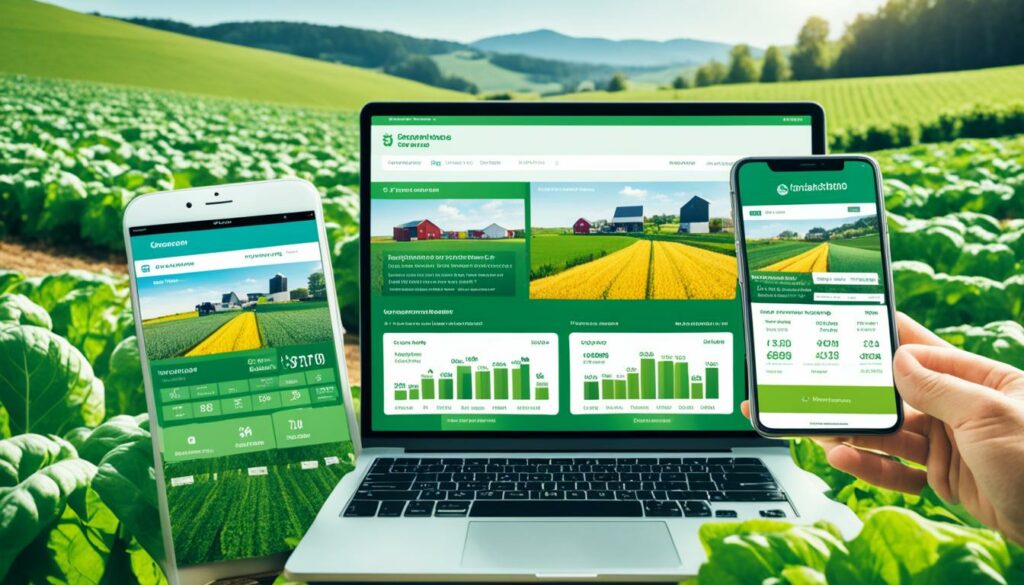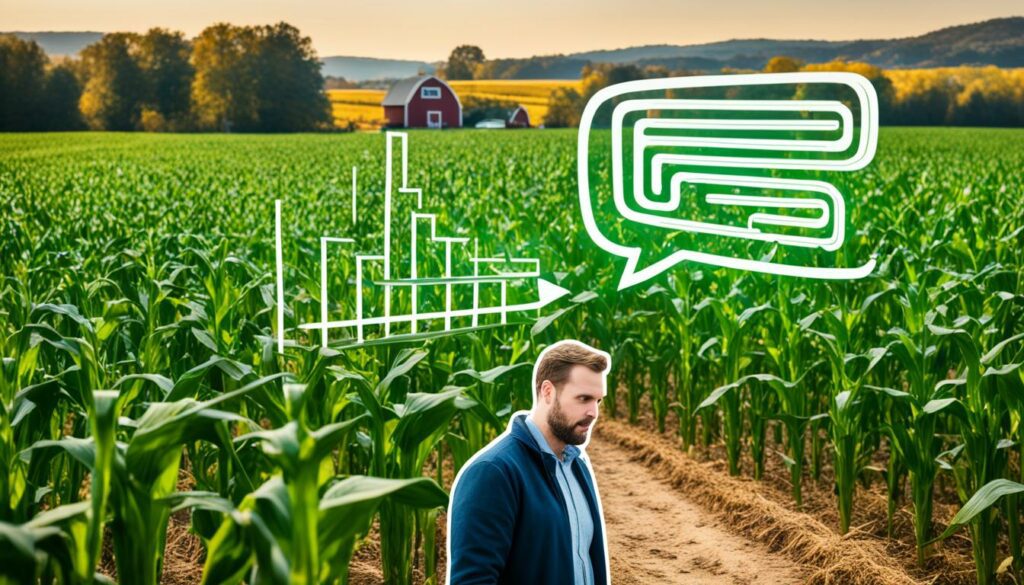Menu

Did you know, 84% of professionals skip measuring their social media ROI? This is both a challenge and an open door for farms. They can boost marketing efforts by correctly utilising social media. Measuring social media ROI in farming means checking the value from online activities. This checks if money, time, and effort put into social media are reaching farm goals. These goals might be about getting the brand seen more, engaging with the community, or selling more farm products.
For farms, finding an easy way to ‘speak numbers’ with social media is key. They need to set clear goals and use tracks such as UTM parameters or conversion pixels. These help to see how online talks turn into actions on a site. It gives solid information. Also, looking at costs both in money and other ways (like time) helps get the true ROI picture. Metrics such as likes, shares, and comments show how much people like or talk about the farm. By using this data, farms can shape their content to interest more. Smart use of ads boosts ROI too. By looking at these numbers often, farms can learn what works and what doesn’t. This helps make better choices about where to put their resources for the best outcomes.
The *importance of social media for farm growth* is massive. By calculating Social Media ROI, a farm can see if its online efforts are working. As Lewis Carroll said, “If you don’t know where you are going, any road will get you there.” This is very true for social media. Not using *analytics tools* makes it hard to know who’s following and if your work is paying off.
Social Media ROI is about seeing the value from what you put in. It helps you spot which social media sites and actions help your business grow. Goals like more website visitors, sales, or a stronger brand allow you to watch your progress closely. By keeping track with UTM parameters, you’ll see what’s leading visitors to your site.
Figuring out if your campaign worked means looking at how much you spent compared to what you gained. This includes money from ads and time taken, checked against the money you made or saved. Things like likes, shares, and comments show how interested people are. And knowing a customer’s value over time tells you if your social media is doing well.
Improving your Social Media ROI means careful planning. Focusing on what your audience likes, smart ad spending, and constant checks on your data can boost your returns. *Creating content that speaks to your audience*, spending on ads the right way, and always checking your numbers are key ways to do this.
ROI helps measure how good an investment is. In social media, it means setting clear goals and watching certain signs of success. Some businesses might focus on gaining Twitter followers, while others look at different signs based on what they do.
The results of your social media work can vary. Maintaining a Facebook page might pay off in the long run. But, not all efforts will. By comparing the cost, you can see the real value of your social media investment. This also gives you a clear vision of how social media compares to other forms of advertising, which can guide your future marketing plans.
Success in social media campaigns for farms requires setting clear goals. By using SMART objectives, farms can track progress effectively. This approach improves the impact of their social interactions and investments. Investing time in goal setting pays off.

Farms need to clearly define their social media goals. These can include increasing website traffic or brand reach. Since 68% follow brands for new products, setting the right goals is vital. It ensures your strategies match what consumers want.
Tracking conversions is key for social media success. Using tools like UTM parameters helps farms see what works. This leads to improved ROI and performance. Accurate tracking lets you make needed changes.
The table below shows how consumer interaction affects conversions on various platforms:
| Platform | Active Users | Consumer Engagement Trends | Conversion Impact |
|---|---|---|---|
| 2 Billion | High visual engagement | Significant boost in product interest | |
| TikTok | 1 Billion | 78% users purchase post creator content | Strong conversion rates |
| 4 out of 5 members in B2B decisions | Professional network interactions | Effective for B2B leads | |
| 366 Million | 60% female audience | High conversion for lifestyle products |
By combining smart goal setting with effective conversion tracking, farms can ensure their social media strategies work. They align efforts with clear objectives and achieve measurable success.
Working with consumer insights boosts a farm’s success online. It lets us really understand what consumers do and want. This knowledge turns into plans that work.
Finding your target audience is crucial for online success. Knowing what your consumers like helps create content they love. For example, if people like whisky in the cold, focus on that to boost your results.
Tools like the Meltwater consumer insights solution really help. They are great at understanding the different groups of people in your audience. This makes your marketing hit just the right spot. It means more value over time and a better business run.
To do better on social media, focus on your audience, use good data, and spend smart on ads. Watch the numbers of likes, shares, and comments. They tell you how well you’re doing and help make improvements.
Calculating the social media ROI calculation formula means looking at what you put in compared to what you get out. It shows if the money spent on social media marketing has been worth it. Key parts of this include the money, time, and effort put into it, and what you’ve earned back, like more sales or new customers.
The ROI is the measure used to gauge the efficiency of an investment or to compare multiple investments.
It’s important to figure out what you want from your investment and then see if you got it. This means breaking big goals into smaller, measurable pieces. These vary depending on what your business does. Sometimes, money spent on social media is seen as just buying attention, not an investment that will make money back.

Looking at the social media ROI calculation formula, comparing social media costs to doing things manually is key. This helps you see the actual financial benefit. Setting clear goals is crucial here. It lets you keep track of what’s working by using tools that show how social media brings in sales on a website.
For a more in-depth look, I also consider how long customers stick around and metrics like who’s clicking on ads and sharing content. Knowing what your audience likes helps a lot. So does adjusting ads and content based on what works. You should always check the numbers on social media to make smart choices that improve your ROI.
| Investment Type | Return Metric | Evaluation Tool | Outcome |
|---|---|---|---|
| Financial Investment | Sales Growth | Sales Reports | Increased Revenue |
| Time Investment | Engagement Metrics | Social Media Analytics | Enhanced Interaction |
| Resource Investment | Customer Acquisition | CRM Systems | Expanded Client Base |
Mixing different media, like TV ads and social content, can make your ROI better. It’s really about making your social media more valuable over time. Focusing on the return, not just on getting attention, is what drives successful social campaigns.
When farms pick social media platforms, they should look at how popular the platform is. They should also think about how far it can reach and what kind of content works best there. Right now, only 26% of businesses use social media for their marketing. But, with platforms like Facebook, which has 1.5 billion people using it every month, there’s a huge chance to find customers. Using these platforms lets farmers talk to more people, make their brand known, and get closer to their customers.
Knowing how popular social media platforms are can really help farms. For example, Instagram has 500 million people using it daily. This makes it great for showing stories with photos and videos. Twitter, with its 126 million daily users, is perfect for quick updates and talking about what’s happening in farming.
Each platform has its strengths, and content should match those strengths. Platforms like Instagram and Pinterest work well for beautiful farm photos and for showing off products. LinkedIn is more professional and great for connecting with other businesses and talking about the farming business.
Use Facebook and Instagram to talk to many different customers. Use Twitter and LinkedIn if you want to reach out to farmers or other farming professionals. By choosing the right platforms wisely, farms can make sure they talk to the people who matter most. This way, they get the most out of their social media work.
In today’s world, social media and digital marketing are key for agribusiness development. Good social media marketing can truly boost these ventures. It’s smart to put money into marketing that’s made just for farming, as it can bring good results.
Social media analytics tools are like a guide in our digital efforts. They help us see how well we’re doing on social media. This information changes raw numbers into tips we can use, making it easier for businesses to shape their marketing. By using these tools, we can pay attention to what posts get the most attention and see where our customers go the most online. These things help us find out which online marketing efforts work best.
Digital advertising is more precise than old ways of marketing. Ads on Google, on websites, or on social media catch the eye of particular groups of people. This means more people are likely to buy or share what you’re selling. Watching these ads with social media tools means we use our money in the best way.
Right now, only 26% of businesses are using social media well. So, having good social media tools, like those for Facebook, Twitter, and Instagram, can make a big difference. With billions of people using these social platforms, agribusinesses have a big chance to get their message out. These tools help farms make content that really speaks to people and helps sell their products.

Content Marketing, like writing blogs, making videos, or sharing infographics, is a key way to tell people about farming products and services. By looking at how this content does, farms can tweak their messages to be even more effective. Likewise, Email Marketing is a great way to stay in touch with customers. It helps build trust and lets people know about new things you’re offering.
And, Data Analytics gives real insights about who comes to your website and what they like. Knowing this helps to make better marketing strategies, reaching more people. Mixing these insights with good SEO can bring more people to your site naturally, which is a great mix of marketing tactics.
Getting social media analytics tools is a must for agribusinesses wanting to do well online. These tools turn data into advice that helps us make better choices. They make sure your marketing spends give you the best results.
| Platform | Active Users | Role in Agribusiness Promotion |
|---|---|---|
| 1.5 billion monthly | Wide reach and community building | |
| 126 million daily | Real-time updates and customer interaction | |
| 500 million daily | Visual storytelling and product showcasing |
Social media management software is vital for running social media campaigns well. It lets us keep track of crucial metrics easily. This way, we get to know how well our content is doing and how engaging it is on different platforms.
Systems like HubSpot’s Inbound Marketing Software help us monitor the whole user journey. They connect our marketing efforts with actual customer interactions. This makes it simpler to see what’s effective and what may need changing.
These software tools include advanced tracking features. They help businesses better understand their social media data. This understanding helps shape marketing strategies that target specific groups. Thus, it increases the chances of successful marketing campaigns and higher returns.
Systems like HubSpot also allow for real-time engagement with the audience. This means businesses can interact with customers instantly online. It keeps their social media presence lively and responsive.
Moreover, these tools automate repetitive tasks. This saves time that can be used for more strategic or creative work. For instance, Freedom CRM uses predictive analytics to help businesses predict trends. This enables them to make smart, efficient decisions that foster growth.
Despite the benefits, only a quarter of businesses currently make full use of social media. Yet, platforms like Facebook, Twitter, and Instagram have billions of users. This shows how important it is to invest in good social media management software. It helps companies reach and engage with a massive, active online population.
Today, being active on social media is key for businesses. Big platforms like Facebook and Instagram have many users. Making a plan for social media helps a brand stand out and connect well with people.

Customising content is crucial to grab and keep an audience’s interest. Understanding what the audience likes and needs is important. Posts that link to current events or season trends can make a brand more relatable and interesting.
Real-time interactions are vital. Holding live sessions or chatting instantly make people feel important and the brand more friendly. These efforts help in maintaining a dynamic community that is keen on what the brand offers.
Planning smartly for social media allows businesses to fully use these platforms. This way, they can engage with their audience, create lasting connections, and find long-term success.
Digital marketing helps agribusinesses reach more people in today’s competitive world. Social media ads let farms market their goods and services accurately and effectively online.
One key advantage of social media ads is precision targeting for agribusiness. This feature lets farms focus on certain potential customers for better results. With detailed analytics, I create ads that meet the exact needs and wants of these groups.
On platforms like Facebook, Instagram, and LinkedIn, I can aim ads at people by their age, interests, and habits. So, I can target everyone from young families who want organic food to B2B clients keen on eco-friendly farming. This kind of tailored advertising increases how well ads do and boosts sales.
Ad budget use matters a lot too, through ad budget optimisation. By improving ads based on how they do, I make sure every penny counts. With precise targeting, I avoid spending on ads that don’t work.
By testing and improving on ads, I learn what works best. Tools show me data like how often people click on an ad and how much it costs to get a customer. This info helps me make smart choices, making the most of my ad budget.
As a whole, social media ads and their detailed targeting, along with smart budget usage, can really help farms succeed. With a focus on data and strategy, agribusinesses can reach more customers, grow, and make more money online.
Keeping a close eye on audience interactions helps us know if our social media work is paying off. This insight points us towards things our audience likes and areas where we can do better.
Metrics like likes, shares, comments, and how often people click show us what the audience likes. They guide us in adjusting our content to match what people want.

Facebook has 1.5 billion users a month, while Instagram has 500 million daily users. Twitter sees 126 million daily users and stands out for fast, real-time interactions.
Understanding how much people engage with our content can really boost how people view our brand. Social media is both low-cost and lets us aim our adverts, making our bond with the audience stronger. This is key for businesses like farms, helping them make content that truly connects with their fans.
Watching how people interact with our posts helps us find out what they want. This knowledge makes our social media strategies work better, attracting and keeping customers happy.
| Social Media Platform | Active Users | Engagement Features |
|---|---|---|
| 1.5 billion monthly | Likes, Shares, Comments | |
| 126 million daily | Retweets, Likes, Replies | |
| 500 million daily | Likes, Comments, Stories |
In short, using social media well and paying attention to how people interact with us helps in creating strong relationships.
Adopting advanced social media measurement techniques is key for agribusiness growth. With the decline of traditional marketing, digital tools step in. They let agribusinesses reach wider audiences and connect with them on platforms like Facebook, Twitter, and Instagram.
Data analytics play a crucial role in understanding what website visitors like. This information helps refine marketing strategies. It makes sure campaigns hit their goals and keep people interested. By watching and adjusting these goals over time, farms improve how they connect with their followers. This leads to more interaction and better business outcomes.
On digital platforms, companies can present their offerings to more people. This not only boosts brand awareness but also fosters customer trust. Using targeted digital marketing in farming can bring a big return on investment. It shows that social media is a powerful tool for modern agribusiness.
Picking the right social media channels is vital for farming success. Instagram might be great for stunning visuals, while LinkedIn offers a more professional image. The right choice greatly influences reaching set goals.
To sum up, using strong social media measurement methods, plus keeping a close eye on KPIs, strengthens farm strategies. With the right analytics, agribusinesses can excel in our digital world.
Using analytics is key for farms on social media. They must make smart choices with data to beat their digital rivals. Let’s dive into how spotting trends helps farm’s social media campaigns match what the market wants, boosting interaction.

Finding trends and patterns in social media metrics is vital. It means looking at things like how much people engage, click, and who they are. Seeing what’s popular helps you create posts and strategies that your followers will love. For example, if posts about eco-friendly farming get a lot of likes, you might want to make more of those.
When you know what’s trending, you must adjust your content and campaigns. Keep track and keep up with what your audience likes. This way, your efforts in marketing will actually work to get people’s attention and encourage them to take action.
Consider digital advertising platforms that showcase products with better conversion rates by leveraging analytics. For example:
| Platform | Users | Key Strength |
|---|---|---|
| 2 Billion | Visual Content | |
| Top for B2B | Professional Networking | |
| TikTok | 78% User Purchases | Influencer Marketing |
| Threads | 100 Million in a Week | Rapid Engagement |
So, for farms, it’s essential to use data to keep getting better. By talking about stuff that’s popular and updating as you go, your farm can stay strong and talk effectively to the people you want to reach.
Figuring out social media ROI can be tough for farms. They face challenges like linking sales to specific campaigns and understanding how engaging posts affect earnings. They also have to deal with the changing world of social media and what customers do online.
A good way to measure ROI is by using both numbers and feedback from people. This mix helps farms see if their social media work is really paying off.
Take a look at what experts like Dr. Edward Evans and Ms. Grizelle De Los Reyes have to say. They point out that doing market research is key to overcoming these challenges. Surprisingly, only a quarter of businesses really make the most out of social media, showing there’s lots of room for growth here.
A 2009 study by Mzinga and Babson Executive Education found that a big majority of professionals weren’t checking their ROI. This problem is still big today, even with Facebook and Instagram having billions of users.
One helpful thing is to understand the 4Ps of marketing: Product, Price, Promotion, and Place (Distribution). Focusing on these in your social media plan can make measuring ROI easier.
| Analytical Task | Challenges | Solutions |
|---|---|---|
| Attributing Sales to Campaigns | Disjointed Data Sources | Unified Analytics Platforms |
| Engagement Metrics | Unclear Financial Impact | Linking Metrics to Sales Funnels |
| Platform Changes | Constant Evolution | Continual Learning and Adaptation |
Working on these social media campaign hurdles can help farms understand ROI better. Strong methods and market research are crucial. They improve how farms measure and boost their social media ROI. This means better growth and smarter decisions in the digital world.

In digital marketing today, knowing how social media ROI works is key for farms to grow. It’s not just about making quick money. It’s also about seeing how well social media brings actual results. For example, UTM parameters let farms track how online activities turn into website visits, making ROI clear.
Having clear goals is essential for checking on social media ROI progress. These goals match each campaign with the overall plan. They help compare what’s spent with what’s made. Watching metrics like likes and comments shows how the audience is involved. This insight improves strategies for a better ROI. It pays to also look at the Customer Lifetime Value. This number shows the long-term worth of customers from social media.
Smart use of paid social ads and improving them constantly is vital. Looking closely at social media stats helps find what works. Advice from experts like Eddie Garrison can be very helpful. And understanding collected data lets farms plan smart, sustainable growth strategies in the digital world.
Start by setting clear goals that match your farm’s aims. Next, use social media tools to watch metrics like likes and reach. Add special tracking codes to see which social posts turn into website visits or sales.
Measuring your social media ROI shows the real value of your marketing. It tells if what you’re doing makes your business stronger. This info helps make your marketing money go further.
Try to get more website visitors, leads, and increase your brand’s awareness. Also, aim to sell more because of your social media activity. These targets help you focus and get the most from your campaigns.
Getting to know your audience better can boost your ROI. Tools like Meltwater help you learn what people like. This knowledge can make your posts more interesting and successful.
The formula is: (Sales – Costs) / Costs * 100. It checks if your expenses on social media give back enough. Apply this to see if your ads or posts are worth the money.
Choose social media platforms based on their popularity and the vibe of your farm. For photos and videos, Instagram and Pinterest work great. For business connections, LinkedIn can be more helpful. Pick platforms that match what you want to show and who you want to see it.
These tools turn raw data into helpful info. They show how people engage with your posts, grow your audience, and take action. With these insights, you can refine your marketing, boost performance, and better your ROI.
Platforms like HubSpot’s Inbound Marketing Software help in tracking how visitors interact with your campaigns. They match your marketing efforts with touchpoints and conversions. This streamlines tracking and makes insights clearer.
Create content that your audience finds interesting and relatable. Also, use tools like live videos and chats to have real-time interactions. This boosts your relationship with your audience.
These platforms let you target ads to specific groups. This increases sales chances. Monitoring your ads lets you use your budget wisely. Keeping your ads updated based on what works best helps maximise your ROI.
Look at likes, shares, comments, and clicks. These numbers show interest and where you can do better. Analysing these helps tweak your strategies for more success.
Use up-to-date tools to study data and trends. Focus on KPIs to aim your strategies. Regular checks make sure your content stays relevant with your audience’s needs.
Use insights to match your content and campaigns to what your audience wants. This keeps your strategy effective as interests change. Adapting constantly is key to keeping your social media work up to date.
It’s hard to pin sales on a single social media post. Also, the true meaning of likes and shares can be unclear. Stay flexible and use both numbers and feedback to understand your social media’s success.